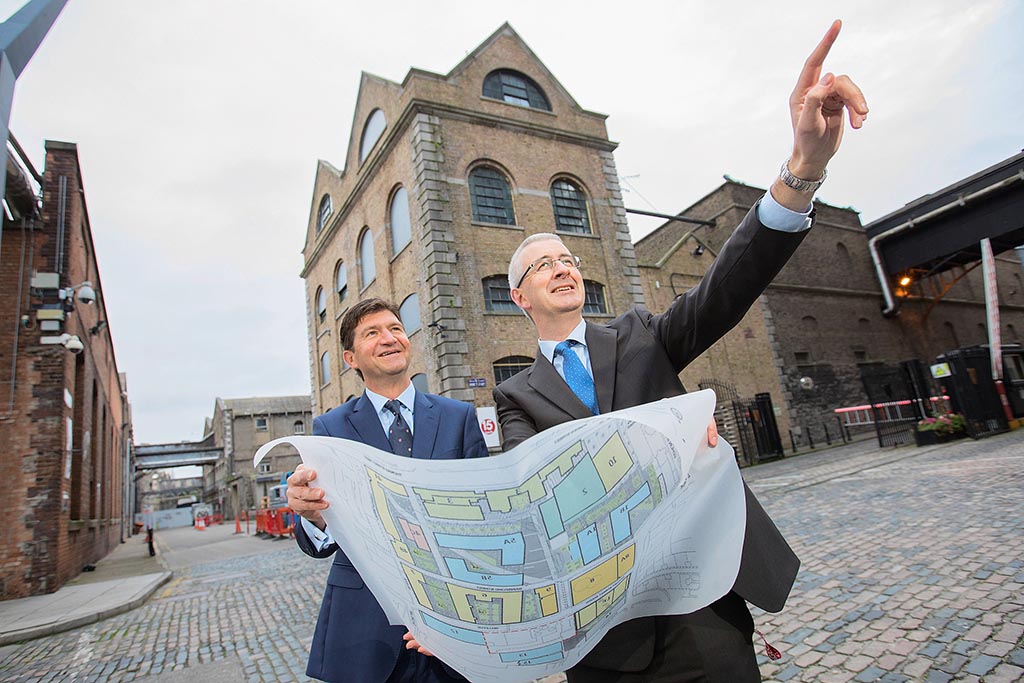THE next chapter in the long history of St James’s Gate has opened after plans for a world-class urban quarter were unveiled last week.
Diageo, the global drinks giant behind the iconic Guinness brand, said they were “opening the gates to welcome doers and dreamers to share our home” as they announced ambitious plans to transform 12.6 acres at the famous site.
The plan is to open up the area by using new and existing buildings to create a dynamic mixed-use urban quarter that will include residential, office and commercial space.
The new St James’s Gate Quarter, as it will be called, will include public spaces and streets that will be fully integrated into the wider Liberties area.
In a bid to create what they envision as one of the most dynamic urban quarters in Ireland and Europe, Diageo said they were commencing the search for a development partner who could make the vision a reality.
“Working closely with planning and architectural experts, Diageo has developed a vision, underpinned by both the Dublin City Development Plan and the Liberties Local Area Plan,” a spokesperson said.
“In the first step of what will be a long-term project, Diageo is embarking on a search for a world class development partner who can help to deliver this transformative vision.
“Given the ambition and size of the project, the development will be phased over a lengthy period, with detailed plans being developed once a partner is in place.”
Diageo plans to retain ownership and custodianship of a number of key buildings in the quarter, including the iconic gate itself and Arthur Guinness’s residence.
Oliver Loomes, Country Director for Diageo Ireland said: “This unique relationship between past and future is what makes St James’s Gate an extraordinary place.
“It is rooted in history and its future is one of innovation and creating experiences.
“We are committed to a long term sustainable future at St James’s Gate and are delighted to be opening streets, creating spaces, and generating opportunity.
“We are transforming our centuries-old vat houses, brew houses and cooperages into incredible spaces that will house and inspire a new generation of entrepreneurs, residents and visitors, dreamers and doers.”
His colleague, Colin O’Brien, added: “Today’s announcement is the next chapter in the history of St James’s Gate.”
Mr O’Brien, the Beer and Packaging Director at Diageo, added: “We have, in this site, a unique opportunity to open up the gates, creating a quarter that will form part of the fabric of the city for generations to come.”
Diageo has continued to invest significantly in operations at the site as it grows its Irish business.
Earlier this year they announced a €16m expansion of the Guinness Storehouse, Ireland’s number one tourist attraction, and the development of a new whiskey distillery on the site of the former Guinness Power Station, at a cost of €25m.
This is in addition to Brewhouse No 4, opened in 2014, which produces 1.2 billion pints of beer annually, with more than 70 per cent exported to 130 countries.
Dublin City Council welcomed the announcement last week, with Chief Executive Owen Keegan describing the plans as “a major step in the rejuvenation of the Liberties”.
“The city council is strongly supportive of the strategy to open up new streets and provide for a variety of homes, which will augment the unique Dublin character of the area and strengthen community identity,” he said.
“Furthermore, the area south of James Street presents an excellent opportunity to integrate historic fabric with high-quality, new buildings and urban spaces with sustainable connectivity to the rest of the city.”
Dublin Chamber said the plans were a great example of sustainable urban planning.
The chamber said the 12.6-acre St James's Gate site has the potential to become a hugely attractive place to live in Dublin and presents a great opportunity to rejuvenate the wider Liberties area.
Dublin Chamber CEO, Mary Rose Burke, said: "The St James's Gate site is one of the most iconic pieces of land in the city.
“It is fantastic to see that part of the site is being reimagined for a new era. Making better use of key land within the M50 is central to meeting Dublin's housing needs.
“This project should serve as an example of the type of thinking that is required to ensure locations are brought back to life to meet the needs of today."
